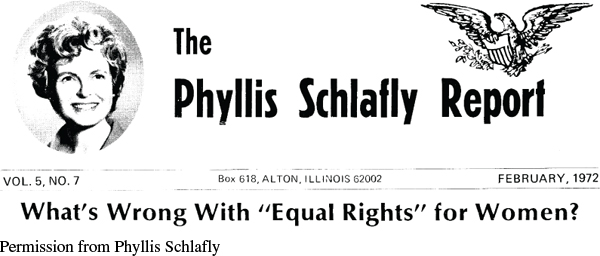Introduction to Chapter 27
27
Conservatism and Its Challengers
1968–1992
WINDOW TO THE PAST
Phyllis Schlafly, “What’s Wrong with ‘Equal Rights’ for Women?” 1972
The conservative writer and political organizer Phyllis Schlafly spoke out forcefully against the women’s liberation movement and its supposedly antifamily values. Believing that American women were happy and fulfilled raising families, she used her Report to rally readers against the Equal Rights Amendment and other aspects of feminism. To discover more about what this primary source can show us, see Document 27.6.

LEARNING OBJECTIVES
After reading this chapter you should be able to:
Explain how President Nixon’s domestic policies and his management of the Vietnam War affected the growth of conservatism.
Evaluate the efforts of President Carter and liberal activists to address the issues of clean energy, equal rights for women, racial equality, and nuclear proliferation in the 1970s.
Discuss the rise of the New Right and analyze President Reagan’s attempt to fulfill its economic and moral objectives.
AMERICAN HISTORIES

For many years Allan Bakke wanted to become a physician, but his life took many detours before he tried to accomplish his ambition. Born in Minnesota in 1940, Bakke grew up in a white middle-class family, earned a degree in mechanical engineering, and served in Vietnam. When his tour of duty was over, Bakke returned home and began working as an engineer in Sunnydale, California.
Finally in 1972 Bakke applied to two California medical schools and was turned down, probably because at age thirty-two he was considered too old. The next year, he applied to twelve schools but was rejected by all of them, including the University of California at Davis. Bakke learned that of the one hundred available spaces in the incoming class, the university awarded sixteen spots to minorities, as part of its affirmative action policy to recruit a more racially and ethnically diverse student body. Contending that the policy amounted to reverse discrimination, he sued the University of California at Davis for violating his constitutional rights of equal protection under the Fourteenth Amendment. He provided evidence that he had higher qualifications than some of the minority students accepted into the medical school. “I realize that the rationale for these quotas is that they attempt to atone for past racial discrimination,” Bakke complained. “But insisting on a new racial bias in favor of minorities is not a just situation.” In 1978, in Regents of the University of California v. Bakke, the U.S. Supreme Court ruled in his favor, and Bakke successfully completed his studies and graduated with a medical degree.
Like Allan Bakke, Anita Faye Hill would gain notoriety in a cause not of her own making. Born in Oklahoma in 1956, Hill grew up in a large family whose ancestors included Creek Indians and former slaves. Like other African Americans in the state, she encountered racial segregation when she attended school, but her parents encouraged her to work hard and abide by strong religious and moral values.
Hill graduated from Yale Law School in 1980. The following year, she went to work in the Office of Civil Rights at the Department of Education. Her boss, Clarence Thomas, also an African American, was a supporter of President Ronald Reagan. When Thomas moved to the Equal Employment Opportunity Commission in May 1982, Hill transferred as well. Although she privately favored affirmative action, Hill tried not to make waves and defended the positions that Thomas implemented to further reduce the scope of affirmative action in the aftermath of the Bakke case.

Anita Hill would have remained an obscure public servant had President George H. W. Bush not nominated Thomas to the Supreme Court in 1991. During the course of Thomas’s Senate confirmation hearing, Hill testified before the Senate Judiciary Committee and a nationally televised audience that Thomas had made unwanted sexual advances to her on and off the job, which she quit in 1983. It was difficult for this usually shy black woman to publicly describe these embarrassing moments concerning a high-ranking black man, but her courage was not rewarded. Black and white conservatives defended Thomas and attacked Hill’s credibility, and Thomas won confirmation by a 52–48 vote. Nevertheless, she became a hero for many working women who faced similar incidents of sexual bias and harassment.
The American histories of Allan Bakke and Anita Hill reveal the profound political importance of ordinary Americans in the larger context of the rise and ascendancy of conservatism in the late twentieth century. Elected in 1968 in the conservative backlash to radical dissent, Richard Nixon ended the war in Vietnam and withdrew from the war on poverty. The Watergate scandal briefly interrupted conservative success with the resignation of Nixon and the election of Jimmy Carter; however, in 1980 Ronald Reagan resumed the conservative ascendency. He led a conservative coalition that meshed the traditional economic conservatism of lower taxes, deregulation, and anti-unionism with the concerns of religious conservatives over patriotism and law and order. His popularity carried over to the election of George H. W. Bush in 1988, and Reagan’s ideas even influenced the Democratic president Bill Clinton, who defeated Bush in 1992. Conservatives reshaped the nation’s political priorities. Still, they neither silenced their progressive critics nor eliminated the impact of liberal achievements from the 1960s.
Exploring American HistoriesPrinted Page 895
Exploring American Histories Value EditionPrinted Page 661
Chapter Timeline